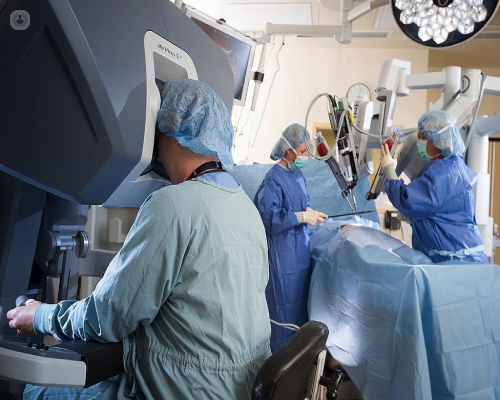Gallbladder removal: new approaches
Autore:When it comes to removing the gallbladder, laparoscopic surgery is currently the gold standard approach, with a small rate of complications and a rapid return to normal activities. But could gallbladder removal be made even safer and less invasive?
In this article, consultant HPB (Liver, Gallbladder/Biliary and Pancreas) surgeon Professor Brian Davidson looks at a selection of new treatment approaches currently being trialled in the UK.

The UK is a world leader in medical innovation and gallbladder surgery is no exception. We have the benefit of a number of large, academic and tertiary referral units where new procedures can be assessed properly for their safety before being rolled out across the UK. With the benefit of newer generation endoscopes (tiny cameras that can be inserted into the body), advanced laparoscopic surgery with high-resolution 4D cameras, robotic surgery and better pre-operative and intra-operative imaging it may be possible to remove the gallbladder in a safer and less invasive manner.
Ultimately, however, we need proof that these techniques really do result in better outcomes. Here are some of the most promising techniques being evaluated:
Single-incision laparoscopic cholecystectomy (SILC)
In this procedure introduced in the early 2000’s surgery is performed through a single incision below the belly button rather than multiple small incisions. The single incision is larger than any of the current laparoscopic incisions. The aim of the technique is to produce a better cosmetic result and to reduce the pain associated with gallbladder surgery. Although early studies suggested that cosmetic results were improved the procedure was more complex due to the small camera and instruments which were required. The view of the site of the operation was reduced and early reviews suggested an increased risk of producing internal injuries because of the reduced visibility. A recent review of all published trials (Surgery 2021) showed SILC to take longer than the other minimally invasive techniques but to have similar outcomes in uncomplicated cases.
Reducing surgical incisions (3 port lap cholyx)
The standard laparoscopic approach to gallbladder surgery uses 4 small incisions through which ports are inserted to insert and remove the camera, instruments and the gallbladder. Some surgeons reduced the ports to 3 in the hope of reducing the pain. No studies have demonstrated significant benefit and the surgeon has a reduced exposure at surgery raising the possibility of increased complications. Currently, the 3-port technique has yet to be shown to be as safe as the 4-port technique.
Needlescopic cholecystectomy
This was introduced almost 10 years ago. It uses smaller ports and instruments for laparoscopic cholecystectomy with the aim of improved cosmesis and less pain. In a recent review of all trials of cholecystectomy approaches it was associated with the lowest rate of wound infection, hospital stay and post-op pain. However, it has not been widely introduced because of the limitations of the fine camera and instruments required and has mainly been assessed in uncomplicated gallbladder surgeries.
Natural orifice transluminal endoscopic surgery (NOTES)
The NOTES technique is a minimally invasive technique that aims to achieve gallbladder removal without any cuts on the abdominal wall. Although these experimental approaches have been described since the early 2000s the data is minimal. A trial was published in 2018 (Surg Endoscopy) suggesting that a transvaginal approach to cholecystectomy was safe but took almost twice as long as a standard laparoscopic approach. Currently, there is no evidence that NOTES offers any significant benefits over laparoscopic cholecystectomy.
Robotic cholecystectomy
Robots were first utilised for cholecystectomy over a decade ago. The robots are fully controlled by the operating surgeon and can provide benefits of very fine instrument movements and excellent high-quality images of the surgical site. Although a place has been established for their use in a few complex procedures for the vast majority of surgeries the outcomes are no different to those of advanced laparoscopic procedures. The current systems are very expensive, cumbersome to set up and dismantle and have a very limited range of instruments. However new more flexible and hybrid laparoscopic/robotic systems are being introduced which may justify their evaluation in smaller surgeries such as cholecystectomy. At present there is rather poor-quality data to suggest similar outcomes with robotic and standard laparoscopic cholecystectomy and no high-quality trials to suggest any benefits of the robotic approach.
Surgical rehearsals: Individual patient surgical simulation
Computer simulation of surgical operations has been used as a tool for many years to prepare surgical trainees to perform procedures before they progress to being mentored directly at surgery. However, the dramatic evolution of computing and imaging technology has recently achieved the ability to use pre-operative imaging to produce a 3D model of any planned surgery. We have developed 3D planning and virtual reality modelling for laparoscopic liver surgery and are developing a training model for laparoscopic cholecystectomy to allow surgeries to be rehearsed, potential difficulties anticipated and complications reduced.
Conclusions
Currently, none of the emerging techniques have demonstrated any clear benefit over the current gold standard of 4 port laparoscopic cholecystectomy.
Many techniques require significant development in the technology before patient benefits are likely. However, there is a caveat. The main driver for change is to reduce complications. The main complications, bile leaks and bile duct injury, occur in about 0.5% (1 in 200) patients. Therefore we will need much larger and better-designed studies to determine whether we are conferring benefits before these new technologies are more widely introduced.
You can request an appointment with Professor Brian Davidson by visiting his profile.


